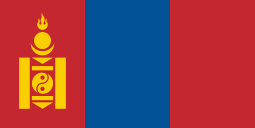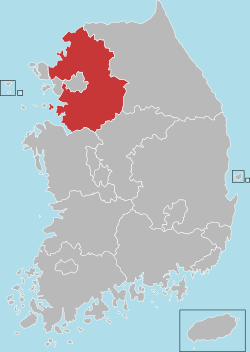Gwangju, Gyeonggi
| Gwangju 광주시 | ||
|---|---|---|
| Municipal City | ||
| Korean transcription(s) | ||
| • Hangul | 광주시 | |
| • Hanja | 廣州市[1] | |
| • Revised Romanization | Gwangju-si | |
| • McCune-Reischauer | Kwangju-si | |
 | ||
| ||
 Location in South Korea | ||
| Country |
| |
| Region | Sudogwon | |
| Administrative divisions | 3 eup, 3 dong, 4 myeon | |
| Area | ||
| • Total | 430.99 km2 (166.41 sq mi) | |
| Population (December 2013) | ||
| • Total | 286,699 | |
| • Density | 665.2/km2 (1,723/sq mi) | |
| • Dialect | Seoul | |
Gwangju[lower-alpha 1] (Korean pronunciation: [kwaŋ.dʑu]) is a city in Gyeonggi Province, South Korea, a suburb southeast of Seoul. The city is not to be confused with the much larger Gwangju Metropolitan City, former capital of South Jeolla Province, South Korea.
History
Bunwon-ri in Gwangju took an important role of ceramic production during the Kingdom of Joseon. There had official kilns and produced superb quality of white porcelains for use at the royal court and to export to China.[3]
In 1962, 4 myuns(towns) including 5 ris(townships) were incorporated to Seoul.[4]
In 1973, 6 of ris were separated and these came to parts of Seongnam city. In 1979, gwangju myun promoted eup. In fact, Gwangju was a county but became a city in 2001.[5]
Notable people
- Kim Yu-bin (1988), singer and actress
- Choi Soo-young (1990), singer and actress
- Lee Hong-gi (1990), singer and actor
- Lee Hye-ri (1994), singer and actress
- Yoon Si Yoon (1986), actor and variety entertainer
Sister cities
Friendship City
 Faku County, China
Faku County, China Dornogovi Province, Mongolia
Dornogovi Province, Mongolia Bathurst City, Australia
Bathurst City, Australia
See also
- Joseon white porcelain
- Korean pottery and porcelain
- List of cities in South Korea
- Geography of South Korea
Notes
References
Citations
- ↑ 광주역사-연혁
- ↑ EB (1878), p. 390.
- ↑ John Onians (2004). Atlas of World Art. Laurence King Publishing. p. 205p. ISBN 1-85669-377-5.
Government-sponsored kilns at punwon-ri, near Seoul, produced an exquisite and distinctive Joseon white porcelain for use at court and for export to China. Its undecorated cream-colored surfaces, and austere elegant shapes were thought to reflect a purity of mind and moral character appropriate for Neo-Confucian patrons.
- ↑ Law concerning Seoul metropolitan city, provinces, counties, districts and counties(1962. 11. 21.)
- ↑ Establishment of new cities including Hwasung.(2000. 12. 20.)
Bibliography
- "Corea", Encyclopædia Britannica, 9th ed., Vol. VI, New York: Charles Scribner's Sons, 1878, pp. 390–394.
External links
| Wikivoyage has a travel guide for Gwangju (Gyeonggi). |
Coordinates: 37°22′N 127°17′E / 37.367°N 127.283°E

